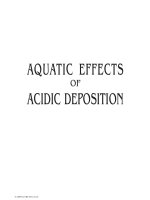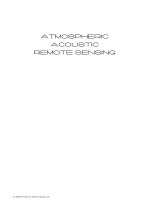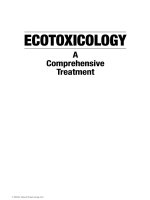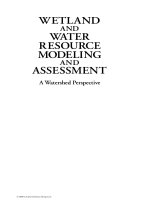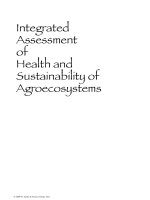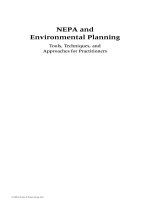NATURAL ORGANICS REMOVAL USING MEMBRANES - CHAPTER 1 ppt
Bạn đang xem bản rút gọn của tài liệu. Xem và tải ngay bản đầy đủ của tài liệu tại đây (1.35 MB, 24 trang )
NATURAL ORGANICS REMOVAL USING MEMBRANES
Copyright © 2001 by Andrea I. Schafer
HOW TO ORDER THIS BOOK
BY
PHONE:
800-233-9936 Or 71 7-291 -5609,
AM- PM
Eastern Time
BY
FM:
71 7-295-4538
BY
MAIL: Order Department
Technomic Publishing Company, Inc.
851 New Holland Avenue, Box 3535
Lancaster, PA 17604,
U.S.A.
BY
CREDIT
CARD: American Express, VISA, Mastercard
PERMISSION TO PHOTOCOPY-POLICY STATEMENT
Authorization to photocopy items for internal or personal use, or the internal or personal use
of specificclients, is granted by Technomic Publishing Co., Inc. provided that the base fee of
US $5.00 per copy, plus US
$.25 per page is paid directly to Copyright Clearance Center,
222
Rosewood Drive, Danvers, MA 01923, USA. For those organizations that have been
granted a photocopy license by CCC, a separate system of payment has been arranged.
The fee code for users of the Transactional Reporting Service is
1-58716101 $5.00
+
$.25.
Copyright © 2001 by Andrea I. Schafer
PRINCIPLES, PERFORMANCE
AND
COST
Andrea
Iris
Schafer, PhoDo
Scbd
of
Civil
and
Environmtul Engineeriw
University
of
New
Soutb
Wak,
Australia
Copyright © 2001 by Andrea I. Schafer
Natural
Organics
Removal
Using
Membranes
~TECHNOMIC~U~~~C~~~O~
Technomic Publishing Company, Inc.
851 New Holland Avenue, Box 3535
Lancaster, Pennsylvania 17604 U.S.A.
Copyright
O
2001 by Andrea
I.
Schiifer
All rights reserved
No part of this publication may be reproduced, stored in a
retrieval system, or transmitted, in any form or by any means,
electronic, mechanical, photocopying, recording, or otherwise,
without the prior written permission of the publisher.
Printed in the United States
of
America
l0987654321
Main entry under title:
Natural Organics Removal Using Membranes: Principles, Performance and Cost
A Technomic Publishing Company book
Bibliography: p.
Includes index p. 401
Library of Congress
Catalog Card No. 2001088343
ISBN NO. 1-58716-093-5
Copyright © 2001 by Andrea I. Schafer
For
Moans
Jade
Copyright © 2001 by Andrea I. Schafer
This page intentionally left blank
Copyright © 2001 by Andrea I. Schafer
CONTENTS
Foreword
xvii
Preface
xix
Acknowledgements
xxi
Chapter
1
-
Introdrrction
Chapter
2
-
Charactetisation ofNatrrral Organics
-
A
Review
2.1 INTRODUCTION 6
2.2
DEFINITION OF NATURAL ORGANICS
7
2.2.1
Nature of Different Natural Organics
2.2.2
Definition of Compounds
2.3
ORIGIN OF NATURAL ORGANICS
8
Chemical Formation, Humification and Xgmg
Biologcal Activity
Soil and
Vegetation
Weather and Seasonal Variations
Lake Waters versus Freshwater Streams
Groundwa ter
Pollution
by
Human Activity
Availability for Research
2.4 EXTRACTION OF NATURAL ORGANICS FROM WATERS 10
2.4.1
Ion Eschange Resin
2.4.2
Reverse Osmosis
2.4.3
Desalting
2.4.4
Purification
2.5 CHARACTERISATION OF NATURAL ORGANICS
13
2.5.1
Concentration Measurements of Natural Organics
2.5.2
Aromaticity and Reactivity
2.5.3
Hydrophobicity
2.5.4
Size, Molecular Weight, RadLi of Gyration, Polydispersity
2.5.5
Diffusion Coefficient
2.5.6
Elemental Analysis and Structure
2.5.7
Functional Groups
vii
Copyright © 2001 by Andrea I. Schafer
viii
Contents
2.5.8 Charge and
Acidity
2.5.9 Solubhty and Aggregation of Natural Organics
2.5.10
Micelle Formation of Natural
Organics and Surfactant Characteristcs
2.5.1
1
Structure/Fractal Dimension of Natural Organics
2.6 FRACTIONATION OF NATURAL ORGANICS 24
2.6.1 Particulate/Dissolved Organic Carbon Separation
2.6.2
FX/KI Separation
2.6.3
Size/hnX' Fractionation
2.6.4
Hydrophhc/Hydrophobic Fractionation
2.7
VARIATIONS OF NATURAL ORGANICS CHARACTERISTICS WITH SOLUTION
CHEMISTRY 25
2.7.1 Effect of Organic Concentration
2.7.2 Effect of Ionic Strength
2.7.3 Effect of pH
2.8 INTERACTIONS OF NATURAL ORGANICS WITH OTHER SOLUTES 26
2.8.1 Cations
2.8.2 Trace Metals
2.8.3 Interactions with Other Compounds
2.9 INTERACTIONS OF NATURAL ORGANICS WITH COLLOIDS 28
2.9.1 Characterisation of Natural Organics and Colloid Systems
2.9.2 Organic Adsorption onto Colloids
2.9.3 Colloid
Stabilisation and
Mobilisation
2.9.4 Aggregate Formation and Structure
2.10 NATURAL ORGANICS IN WATER TREATMENT
32
2.10.1 Drinking Water Standards
2.10.2
Treatabllity of
Natural Organics by Different Processes
2.10.3 Disinfection By-Product Formation
2.10.4 Bacterial Regrowth,
Biofhs and
Conditioning Films
2.10.5 Membrane Fouling
Chapter
3
-
Membrane
Review
39
3.1 INTRODUCTION AND OVERVIEW 40
3.2 FUNDAMENTAL PRINCIPLES AND MECHANISMS 42
3.2.1 hficrofdtration
@IF)
3.2.2 Ultrafdtration
(UF)
3.2.3 Nanofdtration
@F)
3.2.4 Reverse Osmosis (RO)
Copyright © 2001 by Andrea I. Schafer
Contents
ix
3.3.1 Membrane Materials for hIF and UF
3.3.2 Membrane Materials for NF and
R0
3.3.3 TFC Membrane
Modification in NF
3.3.4 Membrane Selection, Testing and Evaluation
3.4 RETECTION OF NATURAL ORGANICS AND COLLOIDS 55
3.4.1 hficrofdtration
(MF)
55
3.4.2 Ultrafiltration
(Ul?)
55
3.4.3 Nanofdtration and Reverse Osmosis 57
3.4.4 Variation of Rejection due to
Fouling 62
3.5 FOULING BY NATURAL ORGANICS
AND
COLLOIDS 63
3.5.1 Organic Fouling 63
3.5.2 Inorganic
Fouhg or Scaling
68
3.5.3
Colloid and Particle Fouling
69
3.6
MEMBRANE AND FOULING LAYER CHARACTERISATION 75
3.6.1 Microscopic Techniques
3.6.2 Surface Charge
3.6.3 Hydrophobicity and State
of Water
3.6.4 Deposit Morphology and Surface Analysis
3.7 FOULING CONTROL 78
3.7.1
Pretreatment for Rejection Increase and Fouling Prevention
3.7.2 Backwashing, Backflushing, and Operation Mode
3.7.3 Membrane Cleaning
3.8 MEMBRANE PROCESS APPLICATIONS IN WATER TREATMENT 84
3.8.1 Membrane Processes versus Conventional Treatment
3.8.2 Membranes versus other Alternatives
3.8.3 Micro filtration
3.8.4 Ultrafiltration
3.8.5 Nanofdtration and Reverse
Osmosis
3.8.6 Hybrid Membrane Processes
3.8.7 Cost
3.9 CONCLUSION 89
Chapter
4
-
Materials and Methods
91
4.1 CHEMICALS AND BACKGROUND SOLUTION 92
4.2 ORGANICS 92
4.3 HEMATITE COLLOIDS
(a-FE70d 93
4.4
MEMBRANES 93
4.4.1 bficrofiltration Membranes
4.4.2 Ultrafdtration Membranes
Copyright © 2001 by Andrea I. Schafer
X
Contents
1.4.3 Nanofdtration Membranes 93
4.5 FILTRATION EQUIPMENT
96
4.5.1 Micro filtration Equipment
4.5.2 Ultrafdtration Equipment
4.5.3 Nanofdtration Equipment
4.6 GENERAL ANALYTICAL METHODS 98
4.6.1
pH
Value
4.6.2 Conductivity
4.6.3
Inductively Coupled Plasma
L\tomic Emission
Spectroscopy
(ICP-L\ES)
4.6.4 Ion Chromatography
(IC)
4.7 ORGANICS CHARACTERISATION
99
4.7.1 Dissolved Organic Carbon (DOC)
4.7.2 UV/VTS Spectroscopy
1.7.3 Titration
4.7.4 Elemental Analysis
4.7.5
XAD Fractionation
4.7.6 Cation Content of
Organics
4.7.7 High Performance Size Exclusion Chromatography (HPLC-SEC)
4.7.8 Ultra
filtration Fractionation
4.7.9 Liquid
Chromatography
-
Organic Carbon Detection &C-OCD)
4.7.10 Humic Solubhty and
Aggregation
4.7.11 Viscosity
4.7.12
Matrix Assisted
Laser
Desorption/Ionisation (MALDI)
4.7.13 Diffuse
Reflectance Fourier Transform Infrared Spectroscopy (DRIFT)
4.8 SOLUTION PREPARATION 116
4.8.1 Stable Hematite Colloids in Absence of Organics
4.8.2 Colloids at pH
3
with Organics
4.8.3 Reaction Limited Aggregation
@M)
4.8.4 Diffusion Limited Aggregation
(DLA)
4.8.5 SPO: Aggregates with Organics
4.8.6 OPS: Colloids
Stabilised
with Organics
4.8.7 Coagulation
4.9 PARTICLE AND AGGREGATE CHARACTERISATION 120
4.9.1 Zeta Potential and Mobhty of Particles
4.9.2 Particle Size and Structure
;inalysis/Fractal Dimension (Malvern)
4.9.3 Aggregate Size
4.9.4 ,iggregate Structure
4.9.5 Photon Correlation
Spectroscopy
(PCS)
4.10 MEMBRANE AND DEPOSIT CHARACTERISATION
127
4.10.1 Zeta Potential of Membranes
4.10.2 Field Emission
Scanning Electron
mcroscopp (FESEhl)
4.10.3
Electron Dispersive Spectra
(EDS)
Copyright © 2001 by Andrea I. Schafer
Contents
xi
4.10.4 X-Ray Photoelectron Spectroscopy PPS)
4.10.5 Contact
Angle Measurements
4.10.6 Determination of Membrane
Mass Deposit
Chapter
5
-
MicrojItration
131
5.1
INTRODUCTION
l32
5.2
FILTRATION PROTOCOL
l33
5.3
MEMBRANE CHARACTERISATION
l34
5.4
MF OF ORGANICS IN THE ABSENCE OF INORGANIC COLLOIDS
l36
5.5
MF OF INORGANIC COLLOIDS IN THE ABSENCE OF ORGANICS
137
5.5.1 Effect of Primary Particle Size
5.5.2 Effect of pH
5.5.3 Effect of
Aggregation
5.6
INORGANIC COLLOIDS AT PH
3
WITH ORGANICS
141
5.7
MF OF AGGREGATED COLLOIDS WITH ADDITION OF ORGANICS (SPO)
142
5.7.1 Effect of Membrane Tpe 142
5.7.2 Effect of Organic Type and Concentration 142
5.7.3 Effect of Primary Particle Size 143
5.7.4 Effect of Calcium Concentration 143
5.7.5 Effect
ofstirring 145
5.7.6 Effect of pH 145
5.7.7 Effect of Transmembrane Pressure 146
5.8
MF OF STABILISED COLLOIDS (OPS)
148
5.8.1 Effect of Membrane Type 148
5.8.2 Effect of Organic Type and Concentration 148
5.8.3 Effect of Primary Particle Size 149
5.8.4 Effect of Calcium Concentration 149
5.8.5 Effect of pH 149
5.9
BLOCKING LAW ANALYSIS
150
5.9.1 Stable Colloids
in
the Absence of Organics
5.9.2 Aggregated Colloids with Subsequent
Adltion of
Organics (SPO)
5.9.3
Stabilised
Colloids (OPS)
5.10
MF OF FECL?-COAGULATED SOLUTIONS
154
5.10.1 Microfiltration of Coagulated Organic Solutions
155
5.10.2
hficrofiltration and
Coagulation of Particle Suspensions
156
5.11
SUMMARY
158
5.12
CONCLUSION
160
Copyright © 2001 by Andrea I. Schafer
xii
Contents
Chapter
6
-
ULtrjZtration
161
6.1 INTRODUCTION 163
6.2
FILTRATION PROTOCOL 163
6.2.1 Fractionation and Rejection Experiments
6.2.2
Aggregation Experiments
6.2.3
Fouling Experiments
6.3 MEMBRANE CHARACTERISATION 164
6.3.1 Pure Water Flus
6.3.2 Molecular
Weight Cut-Off or Pore Size
6.3.3 Membrane Surface
Rdughness
6.3.4
Membrane Surface Charge
6.4 RETECTION AND FRACTIONATION EXPERIMENTS 167
6.41 Effect of Ionic Strength
6.4.2 Effect of pH
6.4.3 Effect of Organic Concentration
6.4.4 Effect of Calcium Concentration
6.4.3 Effect of Organic Type
6.4.6
Cation Rejection by UF
6.4.7
UV254,,/DOC Ratio
6.4.8 Comparison of UF Fractionation and Size Exclusion Chromatography (SEC)
6.4.9 Chemical Analysis of
the
UF Fractions Using LC-OCD
6.5 FILTRATION
OF
INORGANIC AGGREGATES
178
6.5.1 Theoretical Considerations
6.5.2 Effect of
KC1
6.5.3 Effect of CaClz
6.5.4 Effect of pH
6.5.5 Effect of
IHSS Fulvic Acid
6.5.6 Aggregate Characteristics and Their Effect on Membrane Filtration
6.6 FILTRATION OF ORGANICS AND CALCIUM 190
6.6.1 Calcium Concentration
6.6.2 Organic Type
6.6.3 Effect of Flus on Fouling
6.6.4
Blochng Law Analysis
6.7 FILTRATION OF INORGANIC COLLOIDS AND ORGANICS 197
6.7.1 Stable Colloids in the Absence of Organics
6.7.2 Aggregates in the Absence of Organics
6.7.3 Colloids
Stabhsed by Organics
(OPS)
6.7.4 Aggregates in Presence of Organics (SPO)
6.7.5 Comparison of klembrane Deposits Formed by OPS and SPO Systems
6.8 COAGULATION PRETREATMENT 204
Copyright © 2001 by Andrea I. Schafer
Contents
xiii
6.8.1 Effect of Ferric Hydroside Flocs on Flus in the *ibsence of Organics
6.8.2
Effect of Ferric Chloride on Rejection and Flus
6.8.3
Coagulation of OPS Systems
6.8.4 Coagulation of SPO Systems
6.8.5
Blochng Law
Analysis
6.9
SUMMARY 211
6.10 CONCLUSION
214
Chapter
7
-
Nanojiltahon
215
7.1 INTRODUCTION 216
7.2 FILTRATION PROTOCOL 216
7.2.1 Membrane Compaction and Baseline
7.2.2 Protocol for Rejection Experiments
7.2.3 Protocol for Recycle Experiments
7.3
MEMBRANE CHARACTERISATION 219
7.3.1 Effect of Temperature on Water Flux
7.3.2 Membrane 'Pore Size'
7.3.3 hIembrane Surface
Charge
7.3.4 Surface Roughness
7.3.5 Contact Angle
7.4 RETECTION EXPERIMENTS 226
7.4.1 Salt Rejection
in
the Absence of Organics
7.4.2 Organics and
Salt
Rejection
in
Synthetic Surface ?Vater Solutions
7.5 FOULING CONSIDERATIONS
238
7.5.1 Mass Balance for Deposit Calculations
7.5.2 Estimation of
Adsorption of Organics on Membrane Surface
7.5.3 Concentration Polarisation and Osmotic Pressure
7.5.4
Mass Transfer Coefficient
and
?Vall Concentration
7.5.5 Osmotic Pressure in Solutions
and Boundary Layer
7.5.6 Solubility of Calcium and Natural Organic Matter
(Nob9
7.6 FOULING EXPERIMENTS 244
7.6.1 Effect of Background Electrolyte
7.6.2 Effect of Organic Type
7.6.3 Effect of Calcium Concentration
7.6.4 Critical Fouling
Conhtions
7.6.5 Effect of
Organic Concentration and Type
7.6.6 Effect of
pH
7.6.7 Effect of Transmembrane Pressure
7.6.8 Effect of Inorganic Colloids
7.7 COAGULATION PRETREATMENT 265
Copyright © 2001 by Andrea I. Schafer
xiv
Contents
7.7.1 Effect of Organic Type 265
7.7.2 Effect of Ferric Chloride on Treatment of Solutions containing Colloids and
HA
266
7.7.3 Effect of Ferric Chloride Addition at Critical Fouling Conditions
268
7.7.1 Permeate LC-OCD Analysis 269
7.7.5 Suggested
Mechanisms 270
7.8 MEMBRANE DEPOSIT MORPHOLOGY STUDIES 272
7.8.1 Electronmicroscopy
7.8.2
XPS Analysis
7.8.3
Contact
Angle
7.9 SUMMARY 276
7.10 CONCLUSION 280
Chapter
8
-
Process
Comparison
8.1 INTRODUCTION 282
8.2 PURE WATER MEMBRANE CHARACTERISTICS 282
8.3 RETECTION OF ORGANICS AND CALCIUM 283
8.3.1 Rejection of Organics and Cations
8.3.2 Rejection Mechanisms
8.4 FOULING BY ORGANICS. CALCIUM AND COLLOIDS 285
8.4.1 Organics and Calcium 285
8.4.2 Colloidal Systems 287
8.5 FERRIC CHLORIDE PRETREATMENT 288
8.5.1 Effect on Rejection
8.5.2 Effect on
Flux
8.6 PROCESS RELIABILITY AND WATER QUALITY 291
8.6.1
Dependence of Product Quality on Organic Type and Solution Chemistry
29 1
8.6.2 Water
Quality 291
8.7 MEMBRANE AREA REQUIREMENTS AND COST 293
8.7.1 Membrane Cost
8.7.2 Membrane Requirements
8.7.3
Water Quality
and Membrane Cost
8.7.4
Effect of
Ferric Chloride Pretreatment
8.8 ENVIRONMENTAL CONSIDERATIONS 298
8.8.1 Energy Requirements 298
8.8.2 Chemicals Addition 298
8.8.3 Concentrate Disposal 299
8.8.4 Health Aspects 300
8.8.5 Treatment Considerations 301
Copyright © 2001 by Andrea I. Schafer
Contents
XV
8.9
CONCLUSION 301
Chapter
9
-
S.ummay
ei.
Concl.sion
Chapter
10
-
F.urtber
Research
Appendix 1
-
Concentration ofNaturaI Organic Matter
Al.l SELECTION OF CONCENTRATION METHOD 314
XI. 1.1
Conventional hlethods
Al. 1.2
Concentration Using Membranes
X1 .l .3
Comparison of Membrane and Adsorption Concentrates
Al. 1.4
Method Selection
A12 SURFACE WATER SOURCE 316
A1.2.1
Choice of Location
316
A1.2.2
Kaw \X7ater Characteris tics
317
A1.3 MEMBRANE PROCESS OPERATION 318
A1.3.1
Microfiltration and Reverse Osmosis Equipment
X1.3.2
Membrane Process Operation
X1.3.3
Freeze Drying
X1.3.4
Analysis
A1.4 RESULTS 321
A1.4.1
Flus and Water Permeability
321
X1.4.2
Organic Carbon Rejection
322
X1.4.3
Rejection of Conductivity
324
A1.4.4
pH
Value
325
A1.4.5
Cation
Analysis
326
X1.4.6
Overall Rejection
327
X1.4.7
MF Backwash Efficiency
329
A1.4.8
Membrane Cleaning and Storage
329
X1.4.9
Mass Balance
329
A1.5 CONCLUSION 331
Appendix
2
-
FiItration System Characterisation
333
A2.1 FILTRATION SYSTEM DESIGNS 334
A2.1.1
Perspes Stirred Cell
A2.1.2
Stainless Steel Stirred Cell
A22
MASS TRANSFER IN STIRRED CELLS
335
A2.3 SHEAR IN
A
CYLINDRICAL CHAMBER STIRRED BY A RADIAL
FLOW IMPELLER 335
A2.3.1
General Description of Flow
A2.3.2
Theoretical Analysis for Shear Predction in Stirred Cell
A2.3.3
Implications of Shear on Agglomerates in Solution
Copyright © 2001 by Andrea I. Schafer
xvi
Contents
Appendix
3
-
Hematite
Pqbarution
(C-F~~Q,)
4
1
A3.1 SYNTHESIS OF HEMATITE PARTICLES 342
A3.2 CHARACTERISATION OF HEMATITE PARTICLES 343
Appendix
4
-
Inshlnment
Ca&ation
34
7
A4.1 ORGANIC CARBON ANALYSIS 348
A-+.
l.
l
Introduction
X4.1.2
Principle
A4.1.3
Oxidation Efficiency and Choice of Standards
'14.
1
+
Operation Mode
,\-l.
1.5
Detection Limit
'14.
l
.6
Errors and Interferences
A4.2 UV/VIS ABSORBANCE 353
,142.1
hiethod
-14.22 ,ibsorbance
Characteristics of NOhf
A4.2.3 Errors and
Interferences
Appendix
5
-
Sohtion
Speciation
Using
MinteqA2
A5.1 INTRODUCTION
-
358
A5.2
MINTEOA2 SPECIATION CODE 358
A521
livailability of Sofhvare and Data Input
358
A5.3 SPECIATION RESULTS 359
,-\5.3.1
pH Calculations as a Function of Partial CO2 Pressure
359
X5.3.2 Solution Speciation
360
A5.3.3
Calcium Precipitation
361
ii5.3.4
Speciation of Systems Containing Organics
363
,15.3.5
Comments on the Membrane Boundary Layer Concentrations
364
A5.4 CONCLUSION 365
Glossary
&
Symbols
References
Copyright © 2001 by Andrea I. Schafer
FOREWORD
Membrane technology is rapidly becoming the preferred method for water treatment. The past decade
has seen an exponential growth in the number of membrane- based plants in operation and this growth
seems unabated. The reasons for this are many including the recognition that membranes can provide a
more complete barrier to pathogens, that the product water quality is less dependent on the feed quality
and that membrane plant are compact with modest energy demand. At the same time we have seen a
dramatic reduction in the cost of membranes making them economically competitive with traditional
processes.
This book, by Andrea Schafer, deals with the other important requirement in water treatment, the
removal of natural organic matter
(NOM). For many water
sources NOM is a problem and must be
removed to avoid the formation of trihalomethanes, by-products in the
dsinfection process. The Water
Industry,
wishing to use membranes, has a choice of options for NOM removal. This book provides
valuable input to that choice. For applications with moderate to high NOM the choice could be
Nanofiltration and for low or intermittent NOM the choice could be Micro- or Ultrafiltration with
chemical coagulant as required. However the optimal choice remains a moot point, driven by costs and
operational issues.
Having interests in the application of membranes and in physico-chemical aspects of water treatment
we have been fortunate to work with and support Andrea Schafer in her journey into the complex
world of NOM and membrane treatment. The literature on both topics is very large and growing. This
book is comprehensive in its coverage of other work. However few texts have tackled the combined
topics in such detail as this. Importantly this text provides a detailed and meaningful comparison
between the membrane options.
In this study each membrane is fully characterised using a range of techniques, and then subjected to a
well-defined protocol. The author has used a wide range of feed materials,
includng the
international
'standards' as well as a preserved sample from a local water source. Real 'raw water' includes NOM,
colloids and cations in
varylng amounts
and the author provides an in depth study of the interaction of
these species with the different types of membrane, from microporous
MF
to nanoporous NF. Factors
such as membrane and species charge,
floc properties
and the effect of coagulants are discussed. The
final chapter of this text brings together the issues of performance of the range of membranes and
provides a comparison based on treated water quality and estimated treatment costs.
This book is very timely and provides a mine of information for the reader. We are sure you will find
the journey a
rewardmg one.
Professor Tony Fane Director UNESCO Centre for
Membrane Science and Technology,
Australia
Professor David LVaite
Director
Centre for Water and Waste Technology,
University of New South Wales, Sydney,
Australia
xvii
Copyright © 2001 by Andrea I. Schafer
PREFACE
This book represents a comprehensive manual for scientists and engineers involved in water
treatment where natural organics, often referred to as
color, are of concern. The work explains
the three pressure-driven
membrane processes of choice: microfiltration, ultrafiltration, and
nanofiltration, with the objective of producing and recording comparable results for each
process, so as to be able to conclude which process is most suitable under specified conditions.
As a prerequisite, a detailed account of natural organics is provided, including the characteristics
of the "organic
color" of waters that can result
in the formation of potentially carcinogenic
chlorination by-products.
Initially prepared as a doctoral dissertation, the current work was requested by researchers
worldwide for it scope of investigation and original data, which led to its publication as a
monograph. After an extensive literature review of both natural organics and their fate in the
environment (Chapter
2)
and a presentation of membrane filtration principles applicable to
water treatment (Chapter
3),
a detailed description is provided of experimental particulars
designed to permit the application of results to other studies (Chapter
4).
In this chapter, stress is
placed on colloid-organic interactions, which are often overlooked in water treatment. The
study used stirred cell equipment, polymeric membranes, and synthetic surface water containing
natural organics, inorganic colloids, and cations.
The subsequent three chapters show the retention results of microfiltration, ultrafiltration and
nanofiltration, respectively, with all processes
being capable of removing
a significant amount of
natural organics. Pretreatment with ferric chloride was required to achieve significant organic
removal with MF and high MWCO UF.
Fouling mechanism
investigations demonstrated that
the crucial parameters were aggregate characteristics (fractal structure, stability, organic-colloid
interactions), solubility of organics and calcium, and hydrodynamics. Mechanisms were
dependent on the pore to solute-size ratio and varied from pore plugging by particles in MF, pore
adsorption of calcium-organic complexes in UF, to precipitation of a calcium-organic complex in
NF. Thorough chemical
characterization of the organics used demonstrated that only size and
aromaticity can be related to fouling.
As a conclusion the book compares processes (Chapter
8)
based on water quality parameters and
cost. It is shown that the cost of microfiltration with chemical pretreatment is similar to that of
nanofiltration for comparable natural organics rejections.
xix
Copyright © 2001 by Andrea I. Schafer
ACKNOWLEDGEMENTS
I
wish to express
my
sincere appreciation to the many individuals who contributed to this book.
In particular, the editor, Joe Eckenrode (Technomic) who put great confidence into this work for
publication, Tony Fane (UNESCO Centre for Membrane Science
&
Technology, University of
New South Wales) and David Waite (Centre for Water and Waste Technology, University of
New South Wales) who supervised the work during its completion. Menachem Elimelech (Yale
University), Mark Wiesner (Rice University) and Pierre Aimar (CNRS Toulouse) reviewed the
work and provided valuable comments.
Netty Sugiharto (UNSW), Osar Hassum-Tenara (UNSW),
Torben Schlieckau (Uni
Hamburg,
Germany),
Axe1 Heuer, Rainer Mauch,
Martina Fischer, Ursula Schwicker (all Uni Stuttgart,
Germany), Emmanuelle Aoustin (ENSCM, France) contributed with experimental work to the
results.
The German Academic Exchange Council
(DAAD),
the CRC for Water Quality and Treatment
and the Australian Government deserve special gratitude for making it all possible by providing
funding.
Thanks to my friends and family
-
thanks for being there when
I
needed you. A very special
thanks to Bryce Richards for his love and being the perfect companion in balancing our many
activities and to Moana Jade, our precious daugther whos contagious joy makes us so much more
efficient and life more worthwhile.
Copyright © 2001 by Andrea I. Schafer
The permission from editors to reprint figures, tables and sections of text from the following
publications is greatly
appreciated.
Desalination, 118, Schafer, A.I.; Fane, A.G.; Waite, T.D., Nanofiltration of Natural Organic
Matter: Removal, Fouling and the Influence of Multivalent Ions, 109-122, copyright 1998, with
permission from
Elsevier Science:
Tables
7.10, 7.25, 7.29, 7.30, 7.38,
7.47and
Figures
4.4, 7.2, 7.16, 7.21, 7.24, 7.38, 7.52.
Journal of Colloid and Interface Science, 212, Waite, T.D.; Schafer, A.I.; Fane,
A.G.;
Heuer, A.,
Colloidal Fouling of Ultrafiltration Membranes: Impact of Aggregate Structure and Size, 264-
274, copyright 1999, with permission from
Academic Press:
Tables
6.5, 6.6, 6.7
and Figures
4.21, 4.24, 4.25, 4.28, 6.20, 6.21, 6.22, 6.23, 6.24, 6.25, 6.26,
6.2
7.
Journal of Membrane Science, 171, 2. Schafer, A.I.; Schwicker,
U.;
Fischer, M.M.; Fane, A.G.;
Waite, T.D., Microfiltration of Colloids and Natural Organic Matter, 151-172, copyright 2000,
with permission from
Elsevier Science:
Figures
4.19- 4.23, 4.31, 5.1
-
5.5, 5.7- 5.11.
Separation and Purification Technology, 22-23. Aoustin,
E.;
Schafer, A.I.; Fane, A.G.; Waite,
T.D., Effect of Humic Substance and Colloid Interactions on Ultrafiltration Behaviour, 63-78,
copyright 2001, with permission from
Elsevier Science:
Table
5.8
and Figures
6.29
-
6.37.
Water Science and Technology, (in press). Schafer, A.I.; Fane, A.G.; Waite, T.D., Direct
Coagulation Pretreatment in Nanofiltration of Waters rich in Organic Matter and Calcium,
copyright 2001, with permission from
IWA
Publishing:
Tables
7.19, 7.26, 7.29, 7.42, 7.46
and Figures
4.4, 7.26, 7.44, 7.46, 7.48
and
7.49.
Desalination, 131, 1-3. Schafer, A.I.; Fane, A.G.; Waite, T.D., Fouling Effects on Rejection in the
Membrane Filtration of Natural Waters, 215-224, copyright 2000, with permission from
Elsevier
Science:
Table
3.1
and Figure
6.46.
Water Research, 35, 6. Schafer, A.I.; Fane, A.G.; Waite,
T.D.,
Cost Factors and Chemical
Pretreatment Effects in the Membrane Filtration of Waters containing Natural Organic Matter,
1509-1517, copyright 2001, with permission from
Elsevier Science:
Tables
8.1, 8.11, 8.12, 8.14, 8.16and
Figures
8.1, 8.2, 8.4, 8.5, 7.46, 8.7, 8.11-8.13.
Copyright © 2001 by Andrea I. Schafer
Chapter
1
INTRODUCTION
Copyright © 2001 by Andrea I. Schafer
INTRODUCTION
Surface water treatment is a controversial issue.
A
healthy balance between possible risks, such as
immediate microbiological contamination and long-term carcinogenic effects due to
dsinfection by-
products,
and the treatment costs is required. Another issue of concern relates to drinking water
standards,
whch seem
unreasonably strict in some countries and practically absent in others. The price
people are required to pap for their water varies with the standards.
What quality of water do we really need?
This leads us to environmental considerations; how much
energy is reasonable to use for water treatment, how much chemical addition can be justified? Do we
really need to treat all the water we use? Are we running out of water and should we start to think
about reuse or focus more on water savings? Are we stuck in a vicious circle of increasing pollution and
conditions
whch require more and more treatment?
Obviously not all of these questions can
be answered in one thesis. This is a thesis about treatment, a
somewhat fundamental
study about what
we can achieve with treatment now and what
inhbits
treatment efficiency.
The
focus is on treatment by alternative membrane processes. What is differmt is
the attempt to compare and evaluate options on the basis of productivity (capital and maintenance
cost), energy consumption and chemical requirements. The results apply to the water that needs to be
treated to achieve specified standards: that part of drinking water which cannot be replaced with
grejwater. The results cannot replace a rethnking and
optimisation of water usage and demand
management.
Man): processes are available to tackle the challenge of providing a safe and affordable drinking water.
Case .studies typically present one particular surface water and one treatment process. It seems that
there is an urgent need to carry out research in a manner that provides comparable results which apply
to a 'general' surface water and which allow an objective comparison of relevant treatment processes.
A
clear understanding of the 'science' of a natural water system and the 'engineering' of treatment and
their interaction seems essential.
Loohng at water treatment
developments in recent years, it is apparent that the most advanced
treatment options are membrane processes. Membranes remove contaminants (depending on the
membrane, anything from bacteria, viruses, particles to dissolved organics and salt) by physical
retention, when the water is forced with an applied pressure through the membrane. Membranes are
fairly new to the water industry and yet their growth in applications is tremendous. This is due to a
steadily decreasing manufacturing cost, a relatively small footprint compared to conventional treatment,
a potential for reduction of chemicals usage and very low maintenance requirements. Yet the
performance of membranes is far from ideal. An artificial membrane cannot
acheve the sophisticated
performance and long lifetime of membranes
we often see in nature. This gives us an idea of the
potential there is for improving the humble state of current commercial membranes.
Pressure driven membrane processes (microfiltration
@IF'),
ultrafiltration
(UF')
and nanofiltration
(W))
allow the production of high quality drinhng waters. Natural organics need to be removed to
increasingly
low levels, as they
are precursors of carcinogenic disinfection by-products. While MF, UF,
and NF can remove natural organics to some extent, pretreatment is required for MF to achieve
sufficient removal, and the higher operating pressures in
NF
may limit process economics. Fouling by
Copyright © 2001 by Andrea I. Schafer
Introduction
3
surface water components such as natural organics, inorganic colloids, and multivalent ions is a threat
to performance and efficiency of all three processes.
In this book pressure-driven membrane processes are compared on the basis of their potential to
remove natural organic matter
(NOM), critical fouling
conditions, and the structure of the deposit
formed in and on the membranes.
An understanding of critical fouling conditions and examination of fouling morphology will lead to
improved performance, which will reflect in a reduced energy
and/or chemicals
requirement of existing
membranes. It map also explain
why membranes do not perform 'ideally' and
how
thls can
be
improved.
It is anticipated that under certain conditions all three processes are capable of producing a high quality
drinking water. For
microfiltration this
requires a pretreatment step. The optimal process or process
combinations may depend on the raw water characteristics and the desired product water quality.
Classical studies of membrane filtration have tended to consider humic substances
(H.S) and multi-
valent ions.
Initial experiments (designed to concentrate NOM as described in detail in
Appendlx
1)
showed a drastic flux decline of the microfiltration process. Analysis of the fouling layer (discussed in
Chapter
2)
suggested the inclusion of inorganic colloids in the study.
Multi-valent ions interact with organics, inorganic colloids and membranes. Real systems are very
complex. An effort to simplify natural systems without losing important factors has been made and the
systems were characterised thoroughly.
Parameters of importance are those variables of a natural surface water
humic substances
(HS)/ Natural
organic matter
@OM) (concentration, type,
characteristics)
mono- and
multivalent salts (concentration, type)
pH and ionic strength
inorganic colloids (concentration, size, aggregate characteristics, charge)
and those of a membrane process,
hydrodynamics (stirring), transmembrane pressure (flux),
membrane (material, 'pore size'
,
surface charge, surface roughness).
The aggregate characteristics of colloids and
flocs such as structure and size are of particular
concern.
Natural waters contain inorganic colloids embedded in organic matrices and the colloids may be in
various aggregation states or simply stabilised by the organics.
It was anticipated that the filtration behaviour could be improved by
changmg the aggregate
characteristics
and
influencing the conformation
of the organic molecules.
In this thesis, the initial chapters provide an introduction with a description of the organics (Chapter
2),
the membrane processes (Chapter
3),
and a general materials and methods section (Chapter
4).
This is
followed by the results of the different processes, microfiltration (Chapter
5),
ultrafiltration (Chapter
6),
Copyright © 2001 by Andrea I. Schafer
4
INTRODUCTION
and nanofiltration (Chapter
7).
The following chapter (Chapter
8)
is then dedicated to finding common
trends in these processes and pointing out potential implications of the results, their application to
understanlng hybrid membrane
processes, and cost issues and product quality issues. Final chapters
include conclusions (Chapter
9)
and outlook with suggestions for further research (Chapter
10)
will
conclude the project.
The study shows a to date unique comparison
oflthe three available processes
MF,
UF
and
NF
for
identical feed solutions.
The
scope of the work is summarised schematically in Figure
1.1.
Figure
1.
l
Schematic des@tion ofthe
NOM
removal
ming
membranes' research scope.
Copyright © 2001 by Andrea I. Schafer

